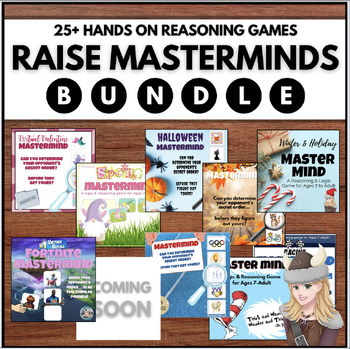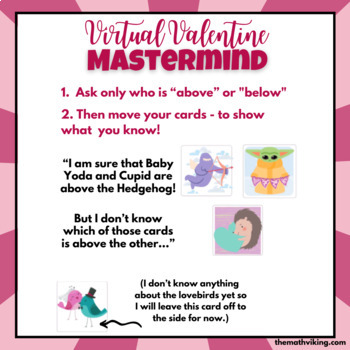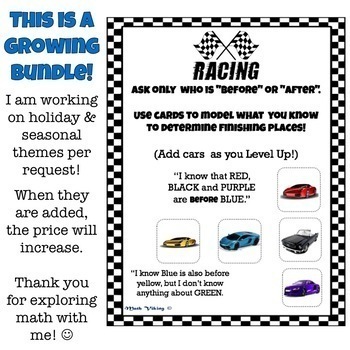Raise MASTERMINDS BUNDLE: Logic Games: Season, Holidays, Fortnite, Super Hero
- Google Slides™

What educators are saying
Products in this Bundle (8)
showing 1-5 of 8 products
Bonus
Description
LOW FLOOR; HIGH CEILING REASONING GAME to develop problem-solving skills! Minutes to learn; a lifetime to master! I have used it from first grade to sixth grade- and family game night and staff meetings. This is enrichment for the whole class. (Also a great way to teach combinations vs. Permutations if you like!)
A very simple premise: students determine the order of the characters.
Who came in first, second third and fourth?
Or who is on the 1st, 2nd, 3rd, 4th and 5th floors?
Asking only yes/no questions about order like, "Are the ice skates above the hot cocoa?" or "Is the pink gnome below the green gnome?" students will keep track of what they learn, and solve the puzzle.
Low floor... means this game can be made accessible for struggling learners or very young learners. High ceiling means it can challenge your advanced students.. or teachers.
Lowest level: Play with 3 characters. Move to 4 as soon as possible.
Highest level: Play with 6 characters!
EACH SET INCLUDES:
1 lesson plan (Directions & Tips)
4 optional recording sheets
3 Introduction Pages for students - one for each theme
Printable character cards to manipulate while you play Master Minds!
THEMES:
HALLOWEEN/ AUTUMN/THANKSGIVING
VIDEO GAME
SUPER HEROES
RACE CAR
EASTER GNOMES
SPRING FUN!
ST. PATRICK'S DAY FUN
WINTER
CHRISTMAS
OLYMPICS
SUMMER coming next!
* I add a new game each year and the bundle price increases, but you will get all of the games for this price so check back and follow for notifications!
*** Email me after purchase for MORE FUN CHARACTER GAMES!
themathviking atgmail dotcom
Provide students with opportunities for patient problem-solving. Engage with fun characters and then MODEL YOUR THINKING using the character cards. Modeling with mathematics is an important practice standard... and it doesn't simply mean using a bar model or an array.
“Modeling” is mathematizing a situation (which includes creating structure and making assumptions) in relation to the context. Modeling is important because it links classroom mathematics to solving problems in everyday life.
Thank you for exploring math with me!
Math Viking
*Please check out my store for products designed to develop deeper understanding! Follow me for notifications about awesome new products. Follow the blog and the facebook page for MORE FREEBIES!
For more Fort Night Video Game fun:
Introduction to Algebraic Equations: Multiplication & Division grades 3-6
Fraction Battle Royale: Includes Bonus Battle Passes & Swag Tags!
To emphasize PROBLEM SOLVING with actual thinking: Go Numberless!:
Grade 2 Standards Numberless Word Problems to Sort & Solve
Grade 1/Early 2 Numberless Word Problem Sort & Solve
Grade 3 Numberless Sort & Solve
Number Composition
Shake, Spill & Show: At the Bakery
THE BIG MOVE From Number Composition to Unitizing
Addition and Subtraction Sorts: Composing Numbers 12 Sorting Activities
For Emerging Place Value Understanding:
PLACE VALUE BAKERY Number Sense and Unitizing Packing: Cookies Tens and Ones
Part Whole Model PLACE VALUE BAKERY Task Cards First & Second Grade
Place Value Fun & Depth of Understanding for one of the BIGGEST standards we teach!
MYSTERY NUMBER Place Value Freebie!
MYSTERY NUMBER Scoot Task Cards for Place Value, Reasoning & Vocabulary
For DOUBLES FACT Fluency Assessments, Games, Interventions & Enrichment check out:
For MATH OLYMPICS check out:
COMPLETE MATH OLYMPICS EVENT PACK: Games, Certificates, Posters & Google Doc
Math Olympics Kindergarten Race to 10 or 20 and Build a Tower
Math Olympics Version of Flexible Place Value Task Cards
For THIRD GRADE ROUNDING, check out:
ROUNDING MOUNTAIN Number Line Rounding Spin It, Show It, Round It Game
For THIRD & FOURTH GRADE Problem Solving:





